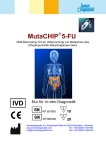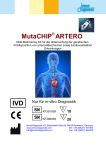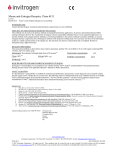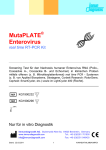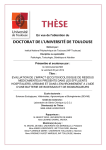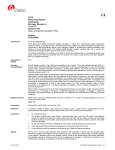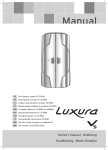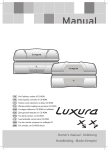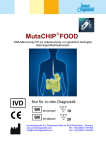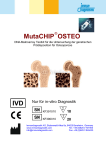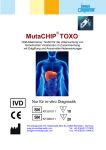Download MutaCHIP Tamox - bei Immundiagnostik
Transcript
® MutaCHIP Tamox DNA-Macroarray Testkit für die Untersuchung von Mutationen des Cytochrom P450 2D6-Gens Nur für in-vitro Diagnostik KF391005 10 KF390005 20 Immundiagnostik AG, Stubenwald-Allee 8a, 64625 Bensheim, Germany www.immundiagnostik.com Tel.: +49 (0)6251/ 701900 [email protected] Fax: +49 (0)6251/ 849430 2 Inhaltsverzeichnis 1 Verwendungszweck 3 2 Einleitung 3 3 Testprinzip 4 4 Kitbestandteile 4 5 Erforderliche Materialien 5 6 Lagerung und Haltbarkeit 5 7 Arbeitsbedingungen 5 8 Hinweise und Vorsichtsmaßnahmen 6 9 Probengewinnung 6 10 Testdurchführung 7 1 PCR ................................................................................................................................... Produktherstellung 7 2 Probenzusammenführung ................................................................................................................................... und Verdünnung 8 3 MutaChip ................................................................................................................................... Protokoll 9 11 Auswertung 10 12 Troubleshooting 14 © 2012 Immundiagnostik AG / Version 2.0 Verwendungszweck 1 3 Verwendungszweck Der MutaCHIP Tamox® Kit ist ein molekularbiologischer Test zur Untersuchung von Mutationen des Cytochrom P450 2D6-Gens aus genomischer DNA. Der Test basiert auf der MutaCHIP Technologie. Die untersuchten Genvarianten stehen im Zusammenhang mit fehlender oder verminderter Aktivität des CYP2D6 Enzyms und in Folge dessen mit der Unwirksamkeit einer Tamoxifen-Therapie. Folgende Allele und Variationen werden durch den Test detektiert: CYP2D6*3 - *11 CYP2D6*17 CYP2D6*29 CYP2D6*41 CYP2D6*xN 2 Einleitung Neben äußeren Einflüssen wie Alter, Geschlecht, Ernährung und Komedikation, gibt es wichtige genetische Faktoren, die die metabolische Aktivität eines Enzyms beeinflussen. Es ist bekannt, dass Patienten, die keine bzw. eine stark reduzierte Aktivität des Cytochrom P450 2D6 Enzyms (CYP2D6) aufweisen, schlechter oder gar nicht auf eine Chemotherapie mit Tamoxifen ansprechen. Tamoxifen ist ein selektiver Östrogenrezeptormodulator, der zur Behandlung von östrogenrezeptorpositiven (ER+) Mammakarzinomen eingesetzt wird. Außerdem kann Tamoxifen als adjuvante Therapie zur Verringerung der Rückfallrate und als Prophylaxe bei Risikopatientinnen verabreicht werden. Die Bindung von Östrogen an seinen Rezeptor hat Einfluss auf die DNA Replikationsrate und führt zu einer erhöhten Zellproliferation im betroffenen Gewebe. Ein ER+ Mammakarzinom zeigt eine Überexpression des Östrogenrezeptors, was in der Folge zu einer größeren Zahl an Mutationen und zur Tumorbildung führt. Tamoxifen wirkt als ER Antagonist und blockiert den Rezeptor, so dass Östrogen nicht mehr binden kann. Da Tamoxifen erst nach der Einnahme durch das CYP2D6 Enzym in seine aktiven Metabolite 4-Hydroxytamoxifen und 4 Hydroxy-N-desmethyl-tamoxifen (Endoxifen) umgewandelt wird, hat die Enzymaktivität einen direkten Einfluss auf den Erfolg Therapie mit Tamoxifen. Beide Metabolite haben eine höhere Affinität zum Östrogenrezeptor als Tamoxifen selbst und sind somit entscheidend für den individuellen Therapieerfolg. Durch eine CYP2D6 Genotypisierung könnten bereits vor Beginn einer TamoxifenTherapie diejenigen Patientinnen erkannt werden, die eine verringerte oder keine Enzymaktivität aufweisen. Dies erlaubt es, solche Patientinnen frühzeitig mit anderen Medikamenten, wie Aromatase Inhibitoren, zu behandeln, die Chancen auf eine erfolgreiche Therapie zu erhöhen und das Risiko einer erneuten Tumorbildung zu minimieren. Die Genotypisierung ist besonders wichtig, da 50 % der kaukasischen Bevölkerung eine veränderte Variante des CYP2D6-Gens tragen und Tamoxifen nicht richtig metabolisieren können. Diese Patientinnen sollten zu Aromatase Inhibitoren wechseln. Referenzen: JAMA, October 7, 2009—Vol 302, No. 13 Breast Cancer Res. 2007; 9(2):103. Breast Cancer Res Treat. 2007 Jan; 101(1):113-21. Cancer. 2008 Feb 1; 112 (3 Suppl):695-9. Pharmacogenomics J. 2009 Aug; 9(4):258-64. © 2012 Immundiagnostik AG / Version 2.0 / 06.12.2012 4 3 Testprinzip Zur Analyse der Mutationen wird das gesamte CYP2D6-Gen mittels PCR amplifiziert, wobei frisch extrahierte genomische DNA des Patienten als Matrize dient. Das Amplifikationsprodukt wird anschließend auf den MutaCHIP gegeben und nach mitgeliefertem Protokoll bearbeitet. Die Analyse mittels Präzipitationsreaktion lässt eine eindeutige Genotypisierung aller auf den MutaCHIP gespotteten Allele des CYP2D6-Gens zu. Das amplifizierte Produkt wird auf den MutaCHIP gegeben und bindet an den dort immobilisierten Sonden. Durch einen Waschschritt werden unspezifisch gebundene Fragmente wieder entfernt. Im Anschluss wird das Enzym hinzugegeben, welches an den Sonden-Fragment-Komplex bindet. Nach Zugabe des Substrats tritt eine Fällungsreaktion an den Stellen, an denen noch DNA gebunden ist, auf. Das farbige Präzipitat wird mit dem Imagereader detektiert und von der dazugehörigen Software ausgelesen und bewertet. 4 Kitbestandteile Jedes Testkit enthält die folgenden Reagenzien zur Durchführung von 20 MutaCHIP Tamox Assays, sowie eine Gebrauchsanweisung. Bezeichnung Gefäßgröße Menge 2D6 - PCR Mix A (grüner Deckel) 2 mL Schraubröhre 1 2D6 - PCR Mix B (gelber Deckel) 2 mL Schraubröhre 1 2D6 - PCR Mix C (blauer Deckel) 2 mL Schraubröhre 1 Polymerase 2 mL Schraubröhre 1 30 mL Plastikflasche 1 2 mL Schraubröhre 1 Washing Buffer 60 mL Plastikflasche 1 Enzyme Mix 4 mL Plastikflasche 1 2 mL Schraubröhre (braun) 2 DNA Ref *1/*1 2 mL Schraubröhre 1 DNA Ref *6/*41 2 mL Schraubröhre 1 1,5 mL Gefäß 20 / 1 Hybridisation Buffer Reaction Optimisation Mix (ROM) Substrate MutaCHIPs Gebrauchsanweisung © 2012 Immundiagnostik AG / Version 2.0 / 06.12.2012 Kitbestandteile 5 5 Erforderliche Materialien Benötigte Geräte - von PharmGenomics erhältlich: Macroarray Analysing Tool (MAAT): o Notebook + CYP2D6 Genotyping Software o MutaCHIP Imagereader o Thermocycler für PCR (Peqlab Primus 25 advanced) o Thermomixer mit Kühlfunktion (BIOR Mixing Block MB-102) Benötigte Geräte und Verbrauchsmaterialien - nicht mitgeliefert: Pipetten: o 0,1 – 2,5 µL o 0,5 - 10 µL o 10 - 200 µL o 100 - 500 µL 0,2 mL PCR Gefäße (steril) (steril) 6 Lagerung und Haltbarkeit Alle Komponenten sind bei 2-8 °C zu lagern. Das Substrat ist unbedingt vor Lichteinwirkung zu schützen. Im Inneren des Beutels befinden sich 5x MutaCHIPs mit jeweils geöffnetem Deckel. Wenn ein Lichtschutzfolien-Beutel geöffnet wurde, müssen die Deckel der darin verbleibenden MutaCHIPs unbedingt geöffnet bleiben, da das Schutzgas entweicht. Die MutaCHIPs können im wieder lose (nicht luftdicht) verschlossenen (keine Klebestreifen verwenden!) Lichtschutzfolien-Beutel mehrere Wochen bei Raumtemperatur (RT) gelagert werden. Dabei einen dunklen und trockenen (vor Feuchtigkeit schützen) Ort zur Aufbewahrung auswählen. Um selbst minimale Performanceverluste zu vermeiden, empfehlen wir jedoch den Verbrauch eines geöffneten MutaCHIP Beutels möglichst innerhalb von zwei Wochen! Die MutaCHIPs sind gegen direkte Sonneneinstrahlung und Staub zu schützen 7 Arbeitsbedingungen Die MutaCHIPs dürfen niemals zentrifugiert werden. Die Oberfläche des MutaCHIPs darf nicht mit der Pipettenspitze berührt werden Der MutaCHIP darf nur mit den im Protokoll erwähnten Substanzen verwendet werden. © 2012 Immundiagnostik AG / Version 2.0 / 06.12.2012 6 8 Hinweise und Vorsichtsmaßnahmen Die Vorschriften und Grundsätze für molekularbiologisches Arbeiten müssen eingehalten werden. Der Test ist zur Verwendung mit frisch extrahierter genomischer DNA aus EDTAVollblut als Ausgangsmaterial geeignet. Nur dann können optimale Ergebnisse sichergestellt werden. Mischen Sie keine Reagenzien aus unterschiedlichen Lots. Die MutaCHIPs sind: o nur für den Einmalgebrauch bestimmt o nur zur in-vitro Diagnostik zu verwenden Der MutaCHIP darf während den Arbeitsschritten nicht austrocken! Der MutaCHIP ist für den Gebrauch mit dem MAAT und der dazugehörigen Software von PharmGenomics ausgelegt. Die Arbeitsschritte zügig durchführen. Alle Ausgangslösungen während des Arbeitens kühlen. Das MutaCHIP-Gefäß mit zwei Händen öffnen. Dabei ist darauf zu achten, dass kein Druck auf den MutaCHIP ausgeübt wird. 9 Probengewinnung Als Matrize für die PCR Amplifikation dient genomische DNA aus EDTA-Vollblut. Die DNAKonzentration sollte zwischen 10-50 ng/µL liegen. Die Reinheit (OD260/280) der DNA sollte höher als 1.8 sein. Für den Assay darf nur hochmolekulare (frisch extrahierte) DNA verwendet werden. © 2012 Immundiagnostik AG / Version 2.0 / 06.12.2012 Probengewinnung 10 Testdurchführung 10.1 PCR Produktherstellung 7 Zur Amplifikation der Ziel-DNA werden drei PCR-Ansätze benötigt. Diese werden wie im Folgenden beschrieben pipettiert. PCR Ansatz 1: Bestandteil Volumen pro 25 µL Reaktionsansatz DNA (min. 120 ng - max. 600 ng) 12 µL 2D6-PCR Mix A (grüner Deckel) 12,5 µL Polymerase 0,5 µL PCR Ansatz 2: Bestandteil Volumen pro 25 µL Reaktionsansatz DNA (min. 40 ng - max. 200 ng) 4 µL 2D6-PCR Mix B (gelber Deckel) 20,5 µL Polymerase 0,5 µL PCR Ansatz 3: Bestandteil Volumen pro 25 µL Reaktionsansatz DNA (min. 40 ng - max. 200 ng) 4 µL 2D6-PCR Mix C (blauer Deckel) 20,5 µL Polymerase 0,5 µL Die Proben in den Thermocycler stellen und das in 10.2 beschriebene PCR Protokoll verwenden. © 2012 Immundiagnostik AG / Version 2.0 / 06.12.2012 8 10.2 Probenzusammenführung und Verdünnung Das PCR-Protokoll muss für jedes Labor erneut etabliert werden, da die verschiedenen Thermocycler unterschiedliche Heizraten haben. Diese Etablierung entfällt, wenn der empfohlene Thermocycler verwendet wird (Peqlab Primus 25 advanced). Für die Etablierung kann mit dem folgenden Standard-Protokoll begonnen werden: Temperatur [°C] Zeit [min] Start 94 3 Denaturation 94 0,5 Primer Hybridisation 68 0,5 Elongation 68 4,5 Denaturation 94 0,5 Primer Hybridisation 60 0,5 Elongation 68 4,5 Final Elongation 72 7 Pause 4 8 1x 10 x 20 x © 2012 Immundiagnostik AG / Version 2.0 / 06.12.2012 Testdurchführung 10.3 9 MutaChip Protokoll A) Vorbereitung des Hybridisierungspuffers Falls der Hybridisation Buffer trüb oder flockig geworden ist, kann dieser für wenige Sekunden in der Mikrowelle (240 W) oder in einem Wasserbad erwärmt und durch Schwenken homogenisiert werden, bis er wieder klar ist. Vor dem Verwenden muss der Puffer auf Raumtemperatur (RT) abgekühlt werden. B) Vorbereitung der DNA Proben Geben Sie 60µl Reaction Optimization Mixture (ROM) in ein 200µl Gefäß Fügen Sie 3µl pro PCR-Produkt (A, B und C) hinzu und vortexen Sie kurz Denaturieren Sie das Gemisch für 2 min bei 95°C Nach der Denaturierung fügen Sie 100µl Hybridisation Buffer hinzu Pipettieren Sie das Gemisch, ohne den Boden zu berühren, in den MutaCHIP C) Hybridisierung Hybridisieren der Probe bei 55°C und 550 rpm für 60 min D) Waschschritte nach der Hybridisierung Den Thermoshaker auf 50 °C temperieren. Achtung: Während des Herunterkühlens des Thermoshakers muss der MutaCHIP unbedingt aus dem Shaker entnommen werden! Der Hybridisation Buffer muss auf dem MutaCHIP verbleiben bis die Zieltemperatur erreicht ist! Achtung: Auf korrekte Einstellung des Volumens achten! Den Hybridisation Buffer aus Schritt C) vollständig entfernen 500 µL Washing Buffer vorsichtig auf den MutaCHIP pipettieren Waschen des MutaCHIPs bei 50°C und 550 rpm für 5 min E) Enzymkonjugation Den Thermoshaker auf 21 °C temperieren. Achtung: Während des Runterkühlens des Thermoshakers muss der MutaCHIP unbedingt aus dem Shaker entnommen werden! Der Washing Buffer muss auf dem MutaCHIP verbleiben bis die Zieltemperatur erreicht ist! Achtung: Auf korrekte Einstellung des Volumens achten! Den Washing Buffer aus Schritt D) vollständig entfernen 100 µL Enzyme Mix vorsichtig auf den MutaCHIP pipettieren Konjugation des MutaCHIPs bei 21°C und 550 rpm für 15 min F) Zweiter Waschschritt Achtung: Auf korrekte Einstellung des Volumens achten! Den Enzym Mix aus Schritt E) vollständig entfernen 500 µL Washing Buffer vorsichtig auf den MutaCHIP pipettieren Waschen des MutaCHIPs bei 21°C und 550 rpm für 5 min G) Färbung Achtung: Auf korrekte Einstellung des Volumens achten! Der Chip darf während und nach dem Färben nicht geschüttelt werden! Den Washing Buffer aus Schritt F) vollständig entfernen. 100 µL Substrate in den MutaCHIP geben und für 5 min bei 21°C inkubieren. Dazu den MutaCHIP in den Thermoshaker überführen (keine Schüttelfunktion aktivieren) Danach das Substrate wieder vollständig entfernen (Pipette) und umgehend 500 µl Washing Buffer hinzugeben MutaCHIP in den Imagereader überführen (auf korrekte Platzierung achten), Bild erstellen und mit der Analyse/ Auswertung beginnen (siehe folgendes Kapitel) © 2012 Immundiagnostik AG / Version 2.0 / 06.12.2012 10 11 Auswertung Die Auswertung erfolgt über das MAAT und die CYP2D6 Software. Die Ergebnisse werden mit Hilfe der Software in einem Report zusammengestellt. Für die Auswertung des Chips folgen Sie der folgenden kurzen Anleitung. Für weitere und detailliertere Informationen sehen Sie bitte im CYP2D6 Software Handbuch nach. Schritt 1: Ein neues Projekt erstellen Klicken Sie auf die Schaltfläche Neues Experiment. Vergeben Sie einen beliebigen Namen für das Experiment und speichern Sie es anschließend, indem Sie auf die Schaltfläche Speichern klicken. Schritt 2: Analyseprozess starten Klicken Sie auf die Schaltfläche Start, um die Datenanalyse zu starten. © 2012 Immundiagnostik AG / Version 2.0 / 06.12.2012 Auswertung 11 Schritt 3: Qualitätsprüfung des MutaCHIPs Um ein einwandfreies Analyseergebnis zu erhalten, muss zunächst die Bildqualität des MutaCHIPs überprüft werden. Staubpartikel auf der Unterseite des MutaCHIPs können die Analyse beinträchtigen. Diese können durch das säubern mit einem weichen und feuchten Tuch entfernt werden. Klicken Sie auf die Schaltfläche Analyse fortsetzen, falls die Bildqualität der in der oberen Abbildung entspricht. © 2012 Immundiagnostik AG / Version 2.0 / 06.12.2012 12 Schritt 4: Genotypisierungsergebnisse Nach der vollständigen Datenanalyse können Sie die Ergebnisse im Analysemodul / Genotypisierungsmodul oder im Diagnosebericht abrufen. Die dabei verwendete Symbole werden in der unten stehenden Tabelle erläutert. Symbole der Software und ihre Bedeutung Der Patient trägt auf beiden Allelen die gesunde Variante der untersuchten genetischen Variation. Der Patient trägt auf einem Allel die gesunde und auf dem anderen Allel die mutierte genetische Variation. Der Patient trägt auf beiden Allelen die mutierte genetische Variation in homozygoter Form. Die Signalwerte der Sonden für diese genetische Variation sind zu gering, um ein valides Ergebnis zu erzeugen. Dies könnte auf Sequenzveränderungen in direkter Nähe zur untersuchten Variation hindeuten. Die anderen Signale werden jedoch durch den Ausfall nicht beeinträchtigt. Beide Sonden für diese genetische Variation erzeugen ein nicht gültiges Signal. Dies könnte auf eine Verschmutzung auf der Chipoberfläche zurückzuführen sein. Die anderen Signale werden jedoch durch den Ausfall nicht beeinträchtigt. © 2012 Immundiagnostik AG / Version 2.0 / 06.12.2012 Auswertung 13 Schritt 5: Diagnostischer Report Um die Daten auszuwerten, lassen Sie sich den diagnostischen Report anzeigen. Klicken Sie hierfür auf die Schaltfläche Report. Zusätzlich können Sie auch ein .pdf Dokument erstellen oder den Report direkt ausdrucken. © 2012 Immundiagnostik AG / Version 2.0 / 06.12.2012 14 12 Troubleshooting Problem Lösung Software Meldung: Warnung! Die Prüfen Sie das Enzym und/oder Substrat. Signale des Biotinreferenzmarkers sind zu Wiederholen Sie den Assay mit neuem niedrig. Dies kann ein Zeichen für einen Enzym/Substrat. fehlgeschlagenen oder nicht ausgeführten Konjugationsschritt sein oder das Enzym ist nicht mehr funktional. Das System muss gestoppt werden. Software Meldung: keine Fehlerangabe ErrorCode - 3011 Der Reader ist nicht richtig angeschlossen. Halten Sie „Esc“ für 3 Sekunden gedrückt und schließen Sie den Reader in der richtigen Art und Weise an - bitte wenden Sie sich an das Benutzerhandbuch des PGDx-Systems. Schlechte Bildqualität Reinigen Sie die Bodenunterseite des Arraygefäßes. Benutzen Sie ein weichesTuch, das mit Desinfektionsmittel angefeuchtet ist. Wiederholen Sie das Foto (es kann notwendig sein diesen Schritt mehrfach zu wiederholen). Unscharfes Bild Reinigen Sie vorsichtig die Kamera mit einem Tuch oder einem Wattstäbchen. © 2012 Immundiagnostik AG / Version 2.0 / 06.12.2012 ® MutaCHIP Tamox DNA Macroarray Kit for the Examination of Mutations in the Cytochrome P450 2D6 Gene For in vitro diagnostics only KF391005 10 KF390005 20 Immundiagnostik AG, Stubenwald-Allee 8a, 64625 Bensheim, Germany www.immundiagnostik.com Tel.: +49 (0)6251/ 701900 [email protected] Fax: +49 (0)6251/ 849430 2 Content 1 Application 3 2 Introduction 3 3 Concept of the Assay 4 4 Components 4 5 Materials 5 6 Storage and Shelf life 5 7 Working Conditions 5 8 Considerations and Precautions 6 9 Sample Collection 6 7 10 Test Procedure 1 PCR ................................................................................................................................... Product Generation 7 2 PCR ................................................................................................................................... Protocol 8 3 MutaCHIP ................................................................................................................................... Protocol 9 11 Evaluation and Interpretation of Results 10 12 Trouble shooting 14 © 2012 Immundiagnostik AG / Version 2.0 Application 1 3 Application The MutaCHIP® Tamox Kit is a biomolecular test for the examination of mutations in the Cytochrome P450 2D6 gene (CYP2D6*3-11, *17, *29, *41 and *xN) from genomic DNA. This test is based on a DNA MutaCHIP technology. The investigated variations are connected to a decreased or absent CYP2D6 enzyme activity, which in turn leads to nonresponsiveness to Tamoxifen therapies. Following alleles and variations are detected by the kit: CYP2D6*3 - *11 CYP2D6*17 CYP2D6*29 CYP2D6*41 CYP2D6*xN 2 Introduction Next to environmental factors like age, gender, nutrition and co-medications, there are important genetic factors influencing the metabolic activity of enzymes. It is known that patients who have no or significantly decreased enzymatic activity of the Cytochrome P450 2D6 (CYP2D6) enzyme do not respond to therapies containing Tamoxifen. Tamoxifen is a Selective Estrogen Receptor Modulator that is applied in the treatment of estrogen receptor-positive (ER+) breast cancer. In addition, it is used as an adjuvant to prevent the relapse of a successfully treated carcinoma, for example after surgical removal, and as a prophylaxis in individuals that are at higher risk of developing breast cancer. The binding of estrogen to its receptor has impact on the DNA replication rate and leads to an increased cell proliferation in the affected tissue. An ER+ breast cancer shows over expression of the estrogen receptor, which in consequence causes a higher number of mutations and tumour formation. Tamoxifen acts as an antagonist to the estrogen receptor, blocking it against estrogen binding. Since Tamoxifen is metabolised to its active forms 4-hydroxyTamoxifen and 4 hydroxy-Ndesmethyl-Tamoxifen (Endoxifen) by CYP2D6, the enzymatic activity has direct impact on the success of a Tamoxifen containing therapy. Both metabolites have a higher affinity towards the estrogen receptor than Tamoxifen and thus are crucial for an individual’s response to chemotherapy. Genotyping the CYP2D6 gene prior to initiating Tamoxifen therapy can identify patients with decreased or absent CYP2D6 activity. This offers the possibility to treat them with other medications, for example aromatase inhibitors, at an early stage and in consequence enhance the chances of a successful therapy and eliminating the risk of tumour reoccurrence. Genotyping seems especially important as about 50 % of the Caucasian population carry a variation of the CYP2D6-Gene and do not metabolise Tamoxifen properly. Those patients should switch to aromatase inhibitors. © 2012 Immundiagnostik AG / Version 2.0 / 06.12.2012 4 3 Concept of the Assay To analyse the mutations a PCR is performed, which amplifies the CYP2D6 gene using freshly extracted genomic DNA as template. The amplification product is transferred to the MutaCHIP and is treated following the provided protocol. The analysis allows distinct genotyping of all variants of the CYP2D6 gene that are spotted onto the MutaCHIP. The amplified product binds onto the MutaCHIP to the immobilised probes. In a washing step the unspecific fragments are removed from the surface. Subsequently, the Enzyme Mix is added to the MutaCHIP, coupling with the probe-target complex. After addition of the substrate, a precipitate will form. This precipitate is then detected by the Image reader and the signals are evaluated by the software. 4 Components Each test kit contains the following components for 20 MutaCHIP Tamox assays and the instruction manual: Description Size of Reaction Tube or Flask Number 2D6 - PCR Mix A (green lid) 2 mL Reaction Tube 1 2D6 - PCR Mix B (yellow lid) 2 mL Reaction Tube 1 2D6 - PCR Mix C (blue lid) 2 mL Reaction Tube 1 ROM (red lid) 2 mL Reaction Tube 1 Polymerase (purple lid) 2 mL Reaction Tube 1 Hybridisation Buffer 30 mL Reaction Tube 1 Washing Buffer 60 mL Plastic Flask 1 Enzyme Mix 4 mL Plastic Flask 1 Substrate 2 mL Reaction Tube (brown) 2 DNA Ref *1/*1 2 mL Reaction Tube 1 DNA Ref *6/*41 2 mL Reaction Tube 1 MutaCHIPs 1.5 mL Reaction Tube 20 Instruction manual / 1 © 2012 Immundiagnostik AG / Version 2.0 / 06.12.2012 Components 5 5 Materials Required materials that can be ordered separately from PharmGenomics: Macroarray Analysing Tools (MAAT): o Notebook + CYP2D6 Genotyping Software o MutaCHIP image reader o Thermocycler (Peqlab Primus 25 advanced) o Thermoshaker with cooling function(BIOR Mixing Block MB-102) Required Materials – not provided pipettes: o 0.1 - 2.5 µL o 05 - 10 µL o 10 - 200 µL o 100 - 500 µL 0.2 mL PCR tubes (sterile) 6 Storage and Shelf life All components are stored at 2-8 °C. The substrate has to be strictly protected against light exposure. The bags contain each 5x MutaCHIPs with open lids. After unsealing a bag, the lids of the remaining MutaCHIPs have to remain open as the protection gas escapes. The MutaCHIPs can be stored in the loosely (not airtight) closed (do not use tape) light-protection bag up to several weeks and room temperature (RT). For storage choose a dry and dark place. To avoid even minimal loss of performance, we recommend using up one bag of MutaCHIPs within two weeks. The MutaCHIPs have to be protected against direct exposure to sunlight and dust. 7 Working Conditions Never centrifuge the MutaCHIPs. Do not touch the surface of the MutaCHIPs with a pipette. Use only substances that are mentioned in the protocol. © 2012 Immundiagnostik AG / Version 2.0 / 06.12.2012 6 8 Considerations and Precautions The guidelines and principles for working in a biomolecular laboratory have to be followed. The test is suitable for genomic DNA freshly extracted from whole EDTA blood as starting material. Only then optimal results are guaranteed. Do not mix reagents from different lots. The MutaCHIPs are: o for single-use only o only for in vitro diagnostics Do not let the MutaCHIP dry out while performing the analysis! The MutaCHIP is designed for the use with the MAAT and the software provided by PharmGenomics. Perform all steps in a timely manner. Keep all stock solutions cooled while working. Always open the MutaCHIP with both hands. Do not apply pressure to the tube. 9 Sample Collection The template for PCR amplification is genomic DNA from EDTA whole blood. The DNA concentration should be between 15 and 30 ng/µL. The minimum DNA purity (A260/A280 ratio) should be higher than OD 260/280 1.8. For the assay high molecular (freshly extracted) DNA has to be used. © 2012 Immundiagnostik AG / Version 2.0 / 06.12.2012 Sample Collection 10 Test Procedure 10.1 PCR Product Generation 7 To amplify the target DNA, three reactions have to be prepared. They have to be pipetted following the schemes below: PCR reaction 1: Reagent Volume per 25 µL reaction mix DNA (min. 120 ng - max. 600 ng) 12 µL 2D6-PCR Mix A (green lid) 12.5 µL Polymerase 0.5 µL PCR reaction 2: Reagent Volume per 25 µL reaction mix DNA (min. 40 ng - max. 200 ng) 4 µL 2D6-PCR Mix B (yellow lid) 20.5 µL Polymerase 0.5 µL PCR reaction 3: Reagent Volume per 25 µL reaction mix DNA (min. 40 ng - max. 200 ng) 4 µL 2D6-PCR Mix C (blue lid) 20.5 µL Polymerase 0.5 µL The samples are placed in the thermocycler and the program described in 10.2 is to be applied. © 2012 Immundiagnostik AG / Version 2.0 / 06.12.2012 8 10.2 PCR Protocol The PCR protocol has to be established anew for each laboratory, as different thermocyclers have different heating rates. This establishment can be omitted when using the recommended thermocycler (Peqlab Primus 25 advanced). The following standard protocol can be used to start the establishing process: Temperature [°C] Time [min] Start 94 3 Denaturation 94 0.5 Primer Hybridisation 68 0.5 Elongation 68 4.5 Denaturation 94 0.5 Primer Hybridisation 60 0.5 Elongation 68 4.5 Final Elongation 72 7 Pause 4 8 Cycles 10 x 20 x © 2012 Immundiagnostik AG / Version 2.0 / 06.12.2012 Test Procedure 10.3 9 MutaCHIP Protocol A) Preparation of the Hybridisation Buffer If the Hybridisation Buffer is turbid or a precipitate can be seen, it has to be heated in a microwave for several seconds (240 W) or in a water bath. Gently shake the Hybridisation Buffer until it gets clear, to homogenise it again. Before usage, it has to be cooled to room temperature (RT). B) Preparation of DNA samples In a 200µl reaction tube add 60 µl of Reaction Optimization Mixture (ROM) Add 3 µl of each PCR product (A, B and C) and vortex briefly Denature the DNA at 95°C for 2 min Add 100 µl of Hybridization Buffer to the sample Load the sample on the MutaCHIP, without touching the bottom of the chip C) Hybridisation Perform the hybridisation at 55°C, 550 rpm for 60 min. D) Washing steps after Hybridisation Set the thermoshaker to 50 °C. Note: During the cooling period the MutaCHIP has to be removed from the thermoshaker! The Hybridisation Buffer has to remain on the MutaCHIP until the target temperature is reached! Caution: Pay attention to the correct adjustment of volume! Completely remove the Hybridisation Buffer from step C) Add carefully 500 µL of Washing Buffer onto the MutaCHIP Wash the MutaCHIP at 550 rpm and 50°C for 5 min E) Enzyme conjugation Set the thermoshaker to 21 °C. Note: During the cooling period the MutaCHIP has to be removed from the termoshaker! The Washing Buffer has to remain on the MutaCHIP until the target temperature is reached! Caution: Pay attention to the correct adjustment of volume! Completely remove the Washing Buffer from step D) Add 100 µL of Enzyme Mix to the MutaCHIP Incubate the MutaCHIP at 550 rpm and 21°C for 15 min F) Washing step after Enyzme conjugation Caution: Pay attention to the correct adjustment of volume! Completely remove the Enzyme Mix from step E) Add of 500 µL Washing Buffer to the MutaCHIP Wash the MutaCHIP at 550 rpm and 21°C for 5 min G) Precipitation Caution: Pay attention to the correct adjustment of volume! Do not shake the MutaCHIP during the precipitation! Completely remove the Washing Buffer from step F) Add 100 µL of Substrate to the MutaCHIP and incubate for 5 min at 21°C. To do so, put the MutaCHIP into the thermoshaker (Do not activate shaking function) Thereafter, remove the Substrate completely (pipette) and immediately add 500 µL of Washing Buffer Place the MutaCHIP into the image reader (pay attention to the correct orientation), take a picture and start with the analysis/evaluation of the results (see following chapter) © 2012 Immundiagnostik AG / Version 2.0 / 06.12.2012 10 11 Evaluation and Interpretation of Results The evaluation is performed using the MAAT and the CYP2D6 Software. The results are compiled with help of the software into a report. For the evaluation of the chip, follow the short instructions below. For further and detailed information, please refer to the CYP2D6 Software handbook. Step 1: Create a new project Click on the button New experiment. Assign an arbitrary name for the experiment and subsequently save it by clicking on the button save. Step 2: Start the analysis process Click on the Start button to initiate data analysis. © 2012 Immundiagnostik AG / Version 2.0 / 06.12.2012 Evaluation and Interpretation of Results 11 Step 3: Quality check of the chip To ensure a correct analysis result, the picture quality of the MutaCHIP has to be checked. Particles of dust on the bottom side of the MutaCHIP can affect the analysis. These can be removed by cleaning with a soft and wet tissue. Follow the instructions given in the screen shown here. Press Continue analysis if the quality of the picture is comparable to the figure above. © 2012 Immundiagnostik AG / Version 2.0 / 06.12.2012 12 Step 4: Genotyping results After the complete data analysis, the results can be access in the analysis module / genotyping module or in the diagnostic report. The used icons are explained in the following table. Symbole der Software und ihre Bedeutung The patient carries on both alleles the healthy variant of the investigated genetic variants. The patient carries on one allele the healthy and on the other allele the mutated genetic variant. The patient carries on both alleles the mutated genetic variation in homozygous form. The signal values of the probes for this genetic variation are too weak for a valid result. This could be caused by other sequence variations in close proximity to the investigated variant. The remaining signals of the assay are not influenced. Both probes for this genetic variant show an invalid signal. This might be caused by impurities or dust particles on the MutaCHIP surface. The remaining signals of the assay are not influenced © 2012 Immundiagnostik AG / Version 2.0 / 06.12.2012 Evaluation and Interpretation of Results 13 Step 5: Diagnostic report To evaluate the results open the diagnostic Report Main. Therefore click on the button Report. Additionally a .pdf document can be created or the report can be directly printed. © 2012 Immundiagnostik AG / Version 2.0 / 06.12.2012 14 12 Trouble shooting Problem Solution Software Message: Warning! The signals of the biotin reference markers are too low. This could be a sign of a failed or missed conjugation step. Alternatively the enzyme could be degraded. The system will be stopped. Check enzyme and/or substrate. Software Message: Warning! The signals of the DNA probes indicate a failed amplification. However, there might be a homozygous deletion of the CYP2D6 gene. Please refer to the handbook under section "Detection of *5 homozygous" Please read paragraph 11.1 Software Message: No error description ErrorCode -3011 Poor image quality Repeat the assay with new enzyme/ substrate The reader is not plugged in properly: Keep “Esc” pressed for 3 seconds and plug in the reader in the right manner – please refer to the user manual of the PGDx System Clean the bottom side of the MutaCHIP using a cotton swab or a cloth wet with disinfectant Repeat the photograph (it can be necessary to repeat this procedure several times) Blurred picture Carefully clean the camera with a cotton swab © 2012 Immundiagnostik AG / Version 2.0 / 06.12.2012




























